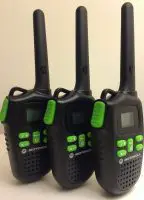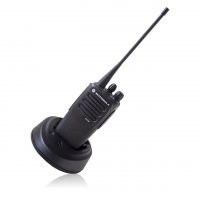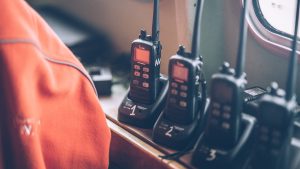For decades, walkie-talkies have been used for a variety of activities, including outdoor recreation, personal and professional communication, and emergency situations. These are radio frequency-operated portable, cost-effective, and reliable gadgets.
Yet, as with any electrical equipment, walkie-talkies can develop issues that impair their usefulness. So, if you are wondering, ‘why does my walkie-talkie not work’, this post will go through some common walkie-talkie issues and how to troubleshoot them.
Table of Contents
Common Walkie-Talkie Problems and How to Troubleshoot Them
1) Walkie-Talkie Won’t Turn On
There could be various reasons why your walkie-talkie won’t switch on.
First, make sure the batteries are properly inserted and have enough charge. Replace any drained or dead batteries with new ones. If the issue does not lie with the batteries, make sure the power switch is turned on. If the walkie-talkie still does not work, it may be malfunctioning, in which case you should contact the manufacturer for assistance.
2) Walkie-Talkie Not Transmitting
You will be unable to connect with the other person if your walkie-talkie is not transmitting. First, confirm that you and the other person are on the same channel and that the walkie-talkies are within range. Verify that the volume is not muted or set to zero.
If this does not resolve the issue, try speaking straight into the microphone while pressing the Push-To-Talk (PTT) button. If there is still no transmission, the equipment may be defective; contact the manufacturer.
3) Walkie-Talkie Not Receiving
There could be a number of reasons why your walkie-talkie is not receiving messages or is sounding muffled. First, make sure you’re on the right channel and that the volume isn’t set to zero or muted.
Check that the walkie-talkie is within range of the other device and that there are no impediments in the way. If you still don’t get reception, consider resetting the device to its default settings or contacting the manufacturer for help.
4) Walkie-Talkies Only Working One Way
There are a number of possible causes if only one of your walkie-talkies is functioning. First, ensure that both devices are tuned to the same channel and that the volume is not muted or set to zero.
Confirm that the two walkie-talkies are within each other’s range without any obstacles in their path. If the problem persists, consider replacing the batteries or resetting the device to factory settings.
If you are still unable to resolve the issue, you may want to reach out to the manufacturer for assistance.
5) Motorola Walkie-Talkie Not Charging
If your Motorola walkie-talkie isn’t charging, start by making sure you have firmly attached the charger to the Motorola walkie-talkie and the electrical outlet.
Check to see that the walkie-talkie charging port is intact and that the device is compatible with the charger. If this problem persists, wipe the port with a dry cloth or get in touch with the manufacturer.
6) Motorola Walkie-Talkie Not Receiving
There are a few reasons your Motorola walkie-talkie could not be receiving messages. First, make sure you have tuned the device to the right channel and not turned the volume to zero.
Also, ensure there are no obstacles in the way and that the walkie-talkie is in the other device’s range. Try returning the device to its factory default settings if the problem still exists, or ask the manufacturer for help.
7) My Walkie-Talkie Doesn’t Work
There are a number of potential causes for a non-functioning walkie-talkie. To begin, make sure the batteries are fully charged. Verify the device is tuned to the proper channel and that you have not muted the volume or set it to zero.
If the device still doesn’t work, you may have a damaged speaker, antenna, or battery to blame. In this case, you might need to replace the broken parts or have a professional fix the device.
8) Midland Radio Won’t Transmit
There are a few things that could be wrong if your Midland radio won’t transmit. First, make sure the device is on the right channel and that the volume is up. Check to see if the batteries are fully charged and if there are any physical obstacles or noise that could be stopping the signal from getting through.
If the problem keeps happening, it could be because the microphone or antenna is broken. In this case, you might need to replace the broken parts or have a professional fix the device.
Common Issues With Walkie-Talkie Batteries and How to Fix Them
Poorly-functioning batteries can significantly limit the usefulness of walkie-talkies. In this section, we will go over some of the most common walkie-talkie battery issues and how you can resolve them.
1) Dead Batteries
Rapid depletion is one of the most typical complications with walkie-talkie batteries. If your walkie-talkie’s batteries fail frequently, they may be outdated and require replacement. To resolve this issue, you must replace the batteries with new ones.
It is crucial to use the correct batteries for the specific model of your walkie-talkie. Check the manufacturer’s instructions to ensure you are using the current kind and size.
2) Low Battery Life
There are various reasons why your walkie-talkie batteries might not be lasting as long as they should. One possibility is that you are utilising a power setting that is higher than intended, which might quickly deplete the batteries. Change the power setting to a lower one to solve this issue.
Also, to conserve battery life, you can try turning off any unneeded functions like the lighting or tone warnings.
3) Overcharging
Overcharging walkie-talkie batteries can damage them and reduce their useful life. To keep your walkie-talkie batteries from overcharging, make sure to charge them as per the manufacturer’s instructions.
Only plug them in to charge for the specified period of time, and remove the plug once they reach full charge.
4) Undercharging
Undercharging the batteries in your walkie-talkie might also be problematic. Your batteries will not last as long as they should if you do not fully charge them.
To prevent this, fully charge your batteries before using them. Additionally, use the correct charging wire and charger for your walkie-talkie model.
5) Battery Corrosion
Batteries for walkie-talkies can also degrade with time, which is a typical issue, particularly if you do not use them frequently. The battery contacts may become damaged by corrosion, which will make it difficult for them to properly connect to the walkie-talkie.
If you find signs of corrosion on your batteries, you can try cleaning the contacts with water and baking soda. Alternatively, you can carefully wipe the contacts using a pencil eraser.
Walkie-Talkie Interference: How to Avoid and Fix it?
Interference is a common problem that can cause walkie-talkies to perform poorly or completely fail. A multitude of factors can contribute to this, including proximal electrical gadgets, conflicting signals, and weather conditions. This section will cover a few ways to avoid interference in the first place, as well as how to address it should it still occur.

1) Avoid Using the Walkie-Talkie Close to Electronics
Technological gadgets, such as televisions, radios, and computers, can emit signals that interfere with your walkie-talkie’s signals. If you are having signal problems, try moving away from potential interference sources.
2) Use the Correct Frequency and Channel
Like we mentioned earlier, using the proper channel and frequency is crucial to ensure the best possible performance. But, if interference still persists, try switching the channel or frequency to see if it helps.
3) Use Noise-Cancelling Headsets
Noise-cancelling headphones are useful for enhancing communication and decreasing background noise in busy environments like construction sites.
4) Keep the Walkie-Talkies away from Other Radios
If you are using more than one walkie-talkie close to each other, keep them apart. The signals from each walkie-talkie can get in each other’s way and affect the devices’ performance.
5) Avoid Using the Walkie-Talkies in Rough Weather
As a result of electrical charges in the air, severe weather like thunderstorms can disrupt transmissions. Thus, in such settings, you should refrain from using walkie-talkies as much as possible.
How to Troubleshoot Walkie-Talkie Range Problems?
Walkie-talkie users frequently experience range problems. If you are experiencing walkie-talkie range problems, below are a few troubleshooting tips to try out:
1) Checking for Obstructions
Physical obstacles like hills, trees, and buildings can reduce a walkie-talkie’s range. Consider relocating to an open space where you can see the other person’s walkie-talkie with no obstructions.
2) Assessing the Batteries
Range issues can also be caused by weak or dead batteries. Make sure to fully charge your batteries. If your batteries are damaged or not operating optimally, you may need to get new ones.
3) Assessing the Antenna
Your walkie-talkie’s antenna is essential for sending and receiving signals. An antenna that is damaged or not fully extended can cause range problems. Make sure the antenna is fully extended and in good condition.
4) Assessing the Weather Conditions
As mentioned, severe weather conditions like strong winds, thunderstorms, or torrential rains can affect a walkie-talkie’s performance, including range. Whenever possible, avoid using your walkie-talkie in harsh weather.
5) Checking the Channels
Check that both walkie-talkies are on the same channel. Range issues can arise if the channels are different.
6) Altering the Power Settings
Adjustable power settings are available on several walkie-talkies. If your walkie-talkie has this feature, you can try changing the settings to extend the range.
7) Using a Repeater
A repeater can be useful if you have to relay messages over a large area. Repeaters are devices that take in a signal and send it out again, allowing your walkie-talkie to cover more ground.
How to Troubleshoot Walkie-Talkie Display Problems
It is not uncommon for walkie-talkies to experience display problems, and they can restrict the usability of the devices. If you are having problems with your walkie-talkie display, here are a few things you can try out:
1) Checking the Battery Level
Display issues can occasionally be caused by low battery levels.
Fully charge the batteries, if needed. Also, if they are outdated or worn-out, you may have to replace them.
2) Checking the Backlight
Some walkie-talkies have a backlight that makes it easier to see the screen when there isn’t much light. Make sure the backlight is on and that the brightness is at the right level for you.
3) Checking the Settings
Make sure to correctly set the tone, frequency, and channel. If the settings are wrong, the display might not work.
4) Examining the Antenna
The screen and the device’s range can be affected if the antenna is broken or damaged in any way. Examine the antenna to ensure it is intact and firmly attached.
5) Resetting the Device
If none of the steps above work, you could try resetting your walkie-talkies. This can help fix any software or hardware problems that might be causing the problem with the screen.
How to Troubleshoot Common Walkie-Talkie Reception Problems
If your walkie-talkie is having trouble receiving messages, you could try taking one or more of the following troubleshooting measures:
1) Examining the Antenna
Make sure the antenna is attached to the walkie-talkie correctly and is not broken. The antenna is a key part of getting signals, and if it is broken or not connected properly, it can make it hard to get signals.
2) Checking your Location
The location of your walkie-talkie can also affect how well it works. Getting messages may be hard if you are in a busy place or a building with thick walls. Try moving to a place with more space or a higher point of view.
3) Checking the Channel
Ensure that you and your communication partner are using the same channel. If you are on separate channels, you cannot hear each other’s messages.
4) Making Sure the Volume is Up
See if your walkie-talkie’s volume is set to the max. If the volume is too low, you may not be able to hear any incoming messages.
5) Checking for Interference
Interference from other electrical equipment or radio transmissions may potentially interfere with reception. Try turning off any surrounding electronics or changing your location to see if this helps reception.
Wrapping Up
In a nutshell, walkie-talkies are adaptable two-way radios that have a wide range of applications. However, like any other electronic device, they are not immune to problems that often impair their performance. By understanding these common problems and knowing how to address them, you can make sure your walkie-talkie will always work when you need it.
To learn more about walkie-talkies and how you can maximise their performance, please check out some of the other resources on our website.





